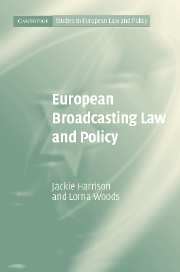Book contents
- Frontmatter
- Contents
- Series Editors' Preface
- Preface
- Case list
- PART I
- PART II
- 6 Access
- 7 Media ownership: impact on access and content
- 8 Jurisdiction, forum shopping and the ‘race to the bottom’
- 9 Advertising placement and frequency: balancing the needs of viewers and commercial interests
- 10 Negative content regulation
- 11 Positive content regulation: quotas
- 12 Privatisation of sport and listed events
- 13 State aid: constraints on public service broadcasting
- PART III
- Appendix
- Bibliography
- Index
11 - Positive content regulation: quotas
Published online by Cambridge University Press: 29 July 2009
- Frontmatter
- Contents
- Series Editors' Preface
- Preface
- Case list
- PART I
- PART II
- 6 Access
- 7 Media ownership: impact on access and content
- 8 Jurisdiction, forum shopping and the ‘race to the bottom’
- 9 Advertising placement and frequency: balancing the needs of viewers and commercial interests
- 10 Negative content regulation
- 11 Positive content regulation: quotas
- 12 Privatisation of sport and listed events
- 13 State aid: constraints on public service broadcasting
- PART III
- Appendix
- Bibliography
- Index
Summary
Introduction
As we argue in chapter 1, the viewing preferences of citizens require a diverse range of programming. The consequences of an increasingly competitive, international media market mean, however, that broadcasters tend to adopt successful formulas based upon tried-and-tested programming formats which are repeated. This approach leads to the safe, the similar and the familiar endlessly occupying programme schedules. Positive content regulation could operate to counter this tendency. The problem as far as the Union is concerned, as we saw in chapters 4 and 5, is that it has limited competence in this regard. If content quotas aimed at protecting citizens' interests are justified by reference to cultural policy, plurality or diversity, the Union does not have direct legislative competence. The Television without Frontiers Directive (TWFD), which includes content quotas, is based on internal market considerations. These considerations result in the quotas being shaped by industrial and commercial concerns, the most typical being the need for a return on investment and the utilisation of national skills pools. The consequence is that quotas are not assessed by reference to the quality of broadcast content, but by reference to formal criteria. Even if things were otherwise, the use of quotas would remain problematic. Some see them as contrary to freedom of expression, while for others they are contrary to international trading rules. The different viewpoints of the member states in this regard are well known, and the lack of agreement led to the quota obligations being phrased in opaque and non-binding terms.
- Type
- Chapter
- Information
- European Broadcasting Law and Policy , pp. 243 - 265Publisher: Cambridge University PressPrint publication year: 2007



